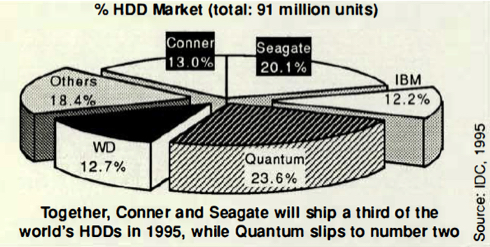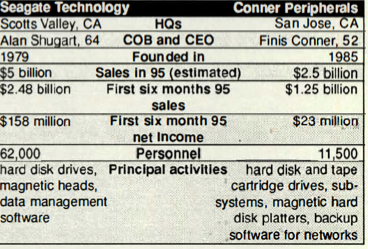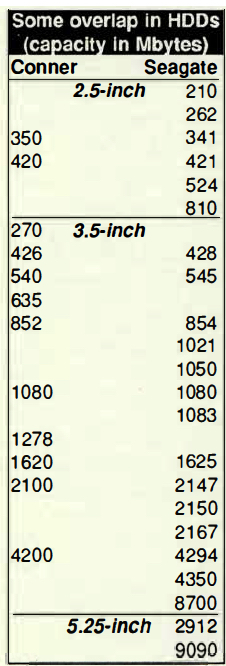History (1995): Seagate Acquires Conner Peripherals for $1 Billion
$7 billion monster born
By Jean Jacques Maleval | September 9, 2019 at 2:20 pmIn what is the largest single deal in the history of storage, and a major development across the electronic information industry altogether, world storage leader Seagate Technology has purchased Conner Peripherals, number three in the field, for $1.040 billion.
The new group, with 70,000 personnel, is now a $7 billion giant, and represents more than a third of the WW HDD drive market.
The sale marks the beginning of the end of a long battle between the two companies, and more, between the two men who stand behind the firms, Alan Shugart and Finis Conner.
In 1992, we posed the question to Alan Shugart, CEO of Seagate: “Do you think it’s possible to imagine a merger between Seagate and Conner? ” At the time, Shugart’s response was: “Anything in the world is possible. I think it’s highly doubtful “. Doubtful or not, today it’s a done deal.
The only thing that could block the merger at this point is a possible antitrust action, which would have little chance of succeeding.
Acquisition more than merger
The joining of the two companies resembles an acquisition-of Conner by archrival Seagate more than a “pooling of interests” and resources.
Conner, according to a reliable American source, was on the market, and discussions with the Korean Samsung, which has indisputable ambitions in storage, were advancing. IBM’s name also came up.
At the beginning, Conner Peripherals (San Jose, CA) was a success story: in 1990, the firm recorded the largest growth of any start-up company in USA history, going from zero to $1.3 billion in four years of activity, due largely to its privileged relations with its major OEM client and stockholder, Compaq.
But Conner has some problems:
1) with its HDD units, some of which were missing key product introductions and whose technological future was therefore doubtful;
2) with its European distribution relations; and
3) with the inauspicious and awkward purchase in 1992 of Archive, a magnetic tape specialist, for $180 million. Furthermore, Conner found itself cash poor and in danger of being unable to announce annual sales growth for the end of this year.
In contrast, management at Seagate (Scotts Valley, CA) found the past few years more serene, particularly in light of their straightforward integration of Imprimis, Control Data’s large subsidiary, acquired for $450 million in 1989.
Together, the two aggregated firms will employ more than 70,000 people and are expected sales to generate business in excess of $7.5 billion this year, far ahead of 2nd place Quantum, no longer world leader in disk drives sold, which finished its fiscal period at the end of March with $3.4 billion in sales, followed by Western Digital whose activity this year should amount to $2 billion.
The Seagate/Conner ensemble will head the pack in disk drives, take second after Hewlett-Packard in tape drives and, considering Conner’s assets include Arcada, make considerable waves with software. In this area, only Cheyenne will come close.
Seagate dives into cartridge drives
For the first time, Seagate will get a foot in the door of magnetic cartridge technology. Time will tell whether Al Shugart, who was never particularly interested in this line, will shed this sector or hang onto it.
A significant portion of the two firms’ HDD units were in direct competition with each other (see table below), although Conner boasted better positioning in desktop PC drives while Seagate flourished in high end units.
Nonetheless there is a promising synergy between Seagate, number one in magnetic heads, and Conner, a major manufacturer of rigid magnetic platters, which together comprise the essential components in the production of Winchester drives. The components world can thus expect a few aftershocks, particularly since Seagate was Komag’s first platter customer, while Conner trailed only Quantum as a major outlet for Read-Rite’s heads.
The union of the two storage giants will no doubt involve major restructuring of their various activities, particularly at the level of upper management, factories and foreign distribution arms.
Al Shugart vs. Finis Conner
Behind the purchase hides a deep-rooted rivalry, despite the fact that both company heads, two of the most important players in HDDs, defend each other when asked about their relations.
After years of working together, beginning at Memorex, Alan Shugart and Finis Conner founded Shugart Associates in 1973, then Seagate Technology in 1979. They ended their partnership in 1984, when Conner left Seagate for reasons of “strategic differences.” Two years later, he challenged Shugart with a rival start-up which became a serious competitor before ultimately yielding to Seagate. For the moment, Shugart has had the last word. Not so long ago we asked Conner’s CEO to explain his curious first name: “I was born in Alabama,” he responded, “and in the old days the silent movies had at the end FINIS and I was the last of five boys in my family, so my mother said FINIS, but being of Alabama, it came out FINE-us.“
Finis finished? It is likely that he will remain a short while at Seagate if only to put his affairs in order, but not much longer than that. A strong personality who knows the mass storage industry inside out, he will no doubt rebound. But working his way backup into a position to challenge a monster like Seagate, and for that matter Shugart, won’t happen overnight.



This article is an abstract of news published on the former paper version of Computer Data Storage Newsletter on issue ≠93, published on October 1995.














 Subscribe to our free daily newsletter
Subscribe to our free daily newsletter

